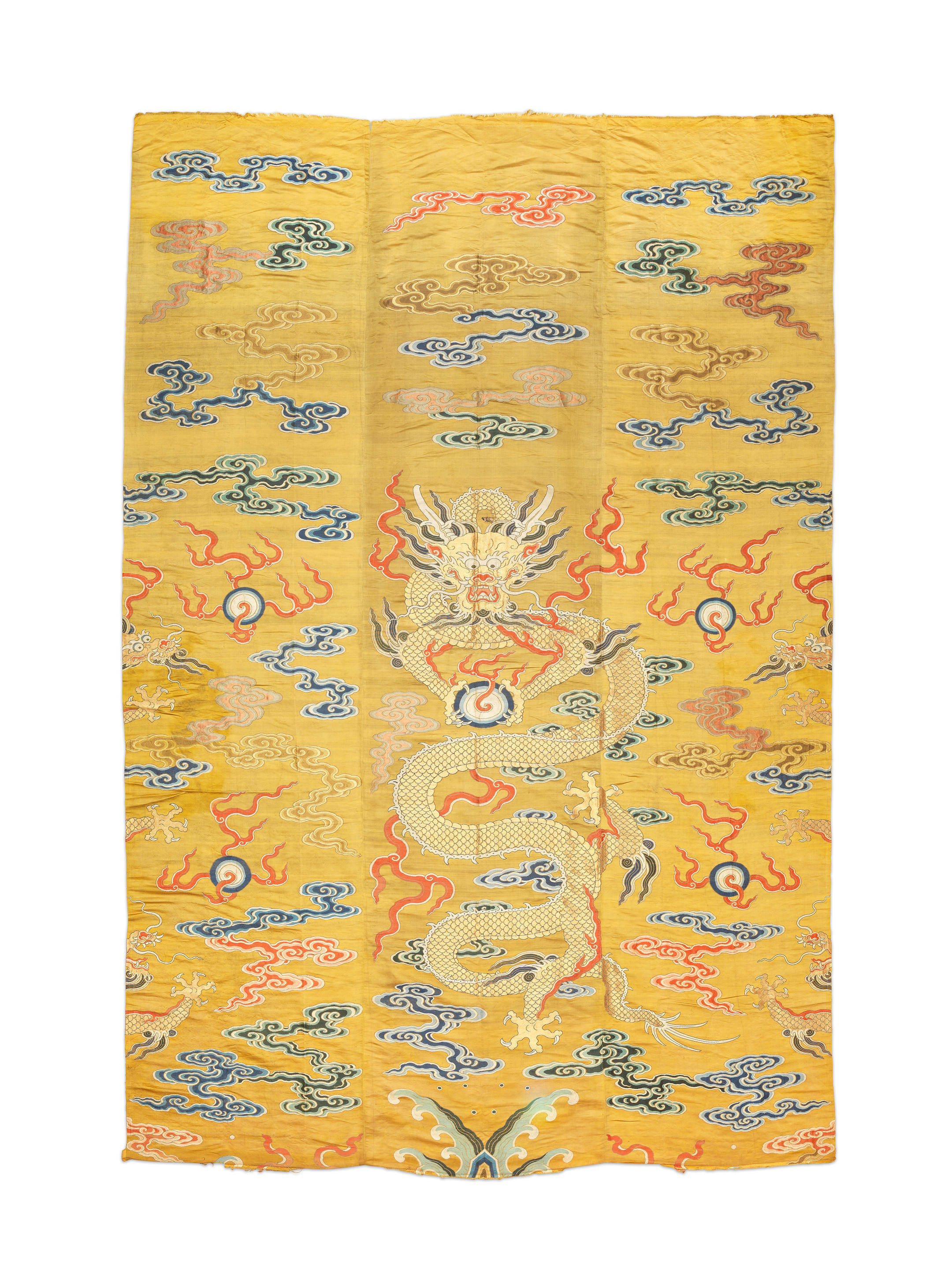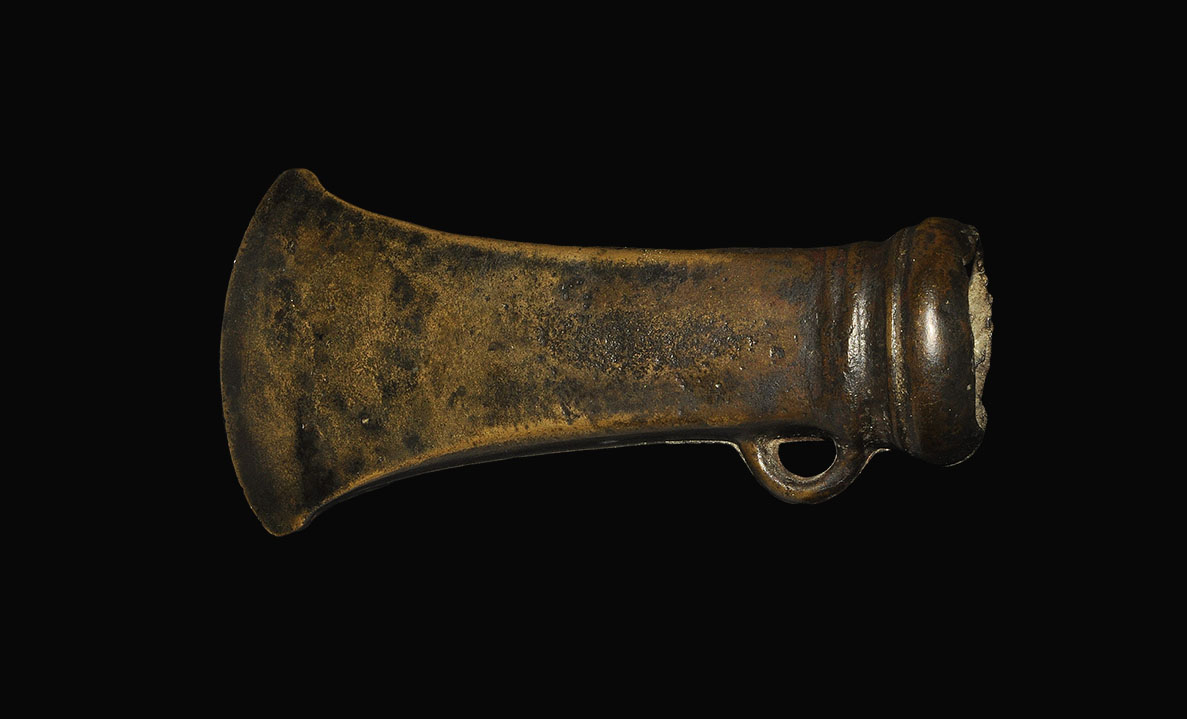Lot details China, 13th-15th century. Heavily cast, the compressed globular body rising from a splayed foot and surmounted by a tall cylindrical neck. The body decorated in relief with archaistic motifs on a key-fret diapered ground at the foot and the four tubular ‘target’ lugs, further molded with four beast-mask handles suspending loose rings, and four chilong sinuously wrapping around the shoulder and elongated neck. Provenance: From the collection of Dr. Walter Rieder (1890-1986), and thence by descent in the same family. Dr. Walter Rieder served in the Swiss East Asia Mission (SOAM) in Qingdao, Shandong Province, between October 1930 and December 1951. The mission specialized in educational, literary, and philanthropic work and Dr. Rieder was in fact, not a theologian or missionary, but a teacher of mathematics, physics, and science to high school students attached to the SOAM. His guiding principles were 'Creating understanding between different cultures' and 'Building bridges between East and West'. While in Qingdao, Dr. Rieder collected a wide variety of Chinese art. The objects in the collection thus offer a unique window into the type of antiques that were on the market in Qingdao in the second quarter of the 20th century. As well as demonstrating his passion for Chinese art, his collection also reveals the personal friendships Dr. Rieder forged with local artists, some of whom he knew from his teaching activities. Dr. Rieder had a scholarly approach to studying his collection. Alongside many of his objects, meticulous notes can sometimes be found detailing his art historical commentaries. The collection was hence Dr. Rieder's gateway to the history and culture of China. Objects from the collection were exhibited at the Kunsthaus in Interlaken, Switzerland in 2006 and 2018. Condition: Very good condition with extensive old wear, few casting irregularities, small losses, nicks and dents, a small hole to the shoulder, possibly inherent to the manufacture. The base plate shows some soldering, but is original to the vase. Dark, naturally grown patina, exactly as expected from this type of bronze. Weight: 6,448 g Dimensions: Height 47.8 cm The form of this vase is inspired by archaic bronze vessels used for touhu (lit. ‘pitch-pot’), a traditional East Asian game that requires players to throw arrows or sticks from a set distance into a large, sometimes ornate, vessel. The game had originated by the Warring States period, probably invented by archers or soldiers as a pastime during idle periods. It began as a game of skill or a drinking game at parties, but by the time it was described in a chapter of the Chinese Classic Book of Rites, it had acquired Confucian moral overtones. Initially popular among elites, it spread to other classes and remained popular in China until the end of the Qing Dynasty. Touhu was usually a contest between players, who had to throw arrows into the mouth or tubular lugs located at the top of the vase, which was placed at an equal distance between two mats on which the players knelt. Touhu vases continued to be produced in the Song dynasty and later, made in various materials including bronze, cloisonné, and ceramic. Literature comparison: See a related bronze arrow vase, dated as first half 17th century, illustrated in The Chinese Scholar's Studio: Artistic Life in the Late Ming Period, New York, 1987, no. 63. Auction result comparison: Type: Closely related Auction: Christie’s London, 11 Nov 2011, lot 1411 Price: GBP 11,250 or approx. EUR 17,000 converted and adjusted for inflation at the time of writing Description: A large bronze 'eight immortals' arrow vase, Ming dynasty (1368-1644) Expert remark: Compare the closely related form, the four beast-mask handles at the body, and the archaistic design to the foot and upper neck. Note the size (57 cm). Auction result comparison: Type: Closely related Auction: Sotheby’s Hong Kong, 7 October 2014, lot 3331 Price: HKD 175,000 or approx. EUR 25,500 c
Lot details China, 13th-15th century. Heavily cast, the compressed globular body rising from a splayed foot and surmounted by a tall cylindrical neck. The body decorated in relief with archaistic motifs on a key-fret diapered ground at the foot and the four tubular ‘target’ lugs, further molded with four beast-mask handles suspending loose rings, and four chilong sinuously wrapping around the shoulder and elongated neck. Provenance: From the collection of Dr. Walter Rieder (1890-1986), and thence by descent in the same family. Dr. Walter Rieder served in the Swiss East Asia Mission (SOAM) in Qingdao, Shandong Province, between October 1930 and December 1951. The mission specialized in educational, literary, and philanthropic work and Dr. Rieder was in fact, not a theologian or missionary, but a teacher of mathematics, physics, and science to high school students attached to the SOAM. His guiding principles were 'Creating understanding between different cultures' and 'Building bridges between East and West'. While in Qingdao, Dr. Rieder collected a wide variety of Chinese art. The objects in the collection thus offer a unique window into the type of antiques that were on the market in Qingdao in the second quarter of the 20th century. As well as demonstrating his passion for Chinese art, his collection also reveals the personal friendships Dr. Rieder forged with local artists, some of whom he knew from his teaching activities. Dr. Rieder had a scholarly approach to studying his collection. Alongside many of his objects, meticulous notes can sometimes be found detailing his art historical commentaries. The collection was hence Dr. Rieder's gateway to the history and culture of China. Objects from the collection were exhibited at the Kunsthaus in Interlaken, Switzerland in 2006 and 2018. Condition: Very good condition with extensive old wear, few casting irregularities, small losses, nicks and dents, a small hole to the shoulder, possibly inherent to the manufacture. The base plate shows some soldering, but is original to the vase. Dark, naturally grown patina, exactly as expected from this type of bronze. Weight: 6,448 g Dimensions: Height 47.8 cm The form of this vase is inspired by archaic bronze vessels used for touhu (lit. ‘pitch-pot’), a traditional East Asian game that requires players to throw arrows or sticks from a set distance into a large, sometimes ornate, vessel. The game had originated by the Warring States period, probably invented by archers or soldiers as a pastime during idle periods. It began as a game of skill or a drinking game at parties, but by the time it was described in a chapter of the Chinese Classic Book of Rites, it had acquired Confucian moral overtones. Initially popular among elites, it spread to other classes and remained popular in China until the end of the Qing Dynasty. Touhu was usually a contest between players, who had to throw arrows into the mouth or tubular lugs located at the top of the vase, which was placed at an equal distance between two mats on which the players knelt. Touhu vases continued to be produced in the Song dynasty and later, made in various materials including bronze, cloisonné, and ceramic. Literature comparison: See a related bronze arrow vase, dated as first half 17th century, illustrated in The Chinese Scholar's Studio: Artistic Life in the Late Ming Period, New York, 1987, no. 63. Auction result comparison: Type: Closely related Auction: Christie’s London, 11 Nov 2011, lot 1411 Price: GBP 11,250 or approx. EUR 17,000 converted and adjusted for inflation at the time of writing Description: A large bronze 'eight immortals' arrow vase, Ming dynasty (1368-1644) Expert remark: Compare the closely related form, the four beast-mask handles at the body, and the archaistic design to the foot and upper neck. Note the size (57 cm). Auction result comparison: Type: Closely related Auction: Sotheby’s Hong Kong, 7 October 2014, lot 3331 Price: HKD 175,000 or approx. EUR 25,500 c




.jpg?mode=max)
.jpg)
.jpg)







Try LotSearch and its premium features for 7 days - without any costs!
Be notified automatically about new items in upcoming auctions.
Create an alert